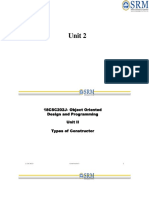0% found this document useful (0 votes)
4 views29 pagesC++ - Unit 3
The document provides an overview of constructors and destructors in C++, explaining their purpose, types, and characteristics. It details default, parameterized, and copy constructors, along with the syntax for defining them, and discusses the role of destructors in memory management. Additionally, it touches on operator overloading, including unary and binary operators, with examples illustrating their implementation.
Uploaded by
jaynthir01Copyright
© © All Rights Reserved
We take content rights seriously. If you suspect this is your content, claim it here.
Available Formats
Download as PDF or read online on Scribd
0% found this document useful (0 votes)
4 views29 pagesC++ - Unit 3
The document provides an overview of constructors and destructors in C++, explaining their purpose, types, and characteristics. It details default, parameterized, and copy constructors, along with the syntax for defining them, and discusses the role of destructors in memory management. Additionally, it touches on operator overloading, including unary and binary operators, with examples illustrating their implementation.
Uploaded by
jaynthir01Copyright
© © All Rights Reserved
We take content rights seriously. If you suspect this is your content, claim it here.
Available Formats
Download as PDF or read online on Scribd
/ 29


























































